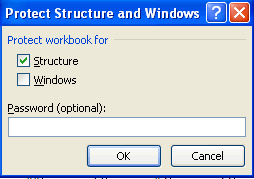Protecting a workbook's structure
To prevent others (or yourself) from performing certain actions in a workbook, you can protect the workbook's structure. When a workbook's structure is protected, the user may not
- Add a sheet
- Delete a sheet
- Hide a sheet
- Unhide a sheet
- Rename a sheet
- Move a sheet
To protect a worksheet's structure:
- Choose Review> Changes> Protect Workbook and click on Protect Structure and Windows to display the Protect Workbook dialog box.

- In the Protect Workbook dialog box, place a check mark next to Structure.
- Enter a password, if desired and Click ok.
To unprotect the workbook's structure, choose Review> Changes> Protect Workbook and click on Protect Structure and Windows for Unprotect Workbook. If the workbook's structure was protected with a password, you are prompted to enter the password.
Protecting a workbook's windows
To prevent others (or yourself) from changing the size or position of a workbook's windows, you can protect the workbook's windows:
- Choose Review> Changes> Protect Workbook and click on Protect Structure and Windows.
- In the Protect Workbook dialog box, place a check mark next to Windows.
- Enter a password, if desired and Click ok.
When a workbook's windows are protected, the user can't change anything related to the window size or position. For example, if the workbook window is maximized when the windows are protected, the user cannot unmaximize the window. The windows can, however, be zoomed.
To unprotect the workbook's windows, choose Review> Changes> Protect Workbook and click on Protect Structure and Windows for Unprotect Workbook. If the workbook's windows were protected with a password, you are prompted to enter the password.
In this tutorial:
- Protecting Excel Data
- Quickly Hide an Open Workbook
- Make a File Read-Only
- Mark a Workbook as Final
- Inspecting a Workbook
- Hide and Unhide Columns and Rows
- Excel Unlock Cells
- Protect Worksheets
- Excel Restrict User Data Entry
- Excel Assign a File Password
- Excel Hide Cell Formulas
- Protecting a workbook's structure
- Using a digital signature in Excel
- Signing a Workbook
